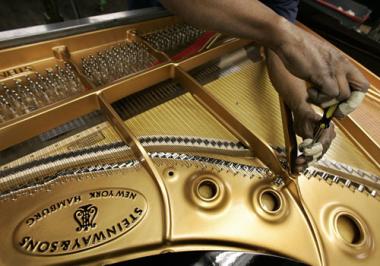Wally Boot, by his own admission, is not a great piano player, but he knows his Beethoven from his Bach. More importantly, certainly for his employers, he has an amazing ear. Twice a week for 10 months of the year, Boot lets his fingers dance across the keys of a brand new nine-foot Steinway concert grand piano before an audience of 20 members of the public at the Steinway and Sons factory in New York.
"These pianos all have personalities of their own," he says, offering a little of Chopin's Prelude in E Minor by way of demonstration. "You can hear it."
The grey-haired, bespectacled Boot, 64, has worked for the legendary piano manufacturers since he was 18 years old and is the last of the many fascinating people you meet on one of the Big Apple's most unique tours.
Hidden in the industrial part of Queens, but easily reachable by subway or taxi, is the expansive Steinway Factory, where, since the late 19th century, the company has produced the finest pianos in the world (98 per cent of piano soloists playing with the world's most renowned orchestras perform on Steinway pianos). The free two-hour tours were started in 2003 to celebrate the company's 150th anniversary; visitors view the factory and interact with workers to see how the legendary pianos are made. The diverse workers, with job titles such as bellyman, grand finisher and stringer, come from 30 different countries and are just as interesting as the work they undertake.
On Mondays and Tuesdays between September and June, two knowledgeable tour guides greet members of the public in the tiny reception room of the Steinway factory and, after handing out multicolored safety goggles, escort them into the factory's basement or the "birth room," as some workers call it, where the year-long process of making a Steinway grand piano begins. I find myself joining a potential customer, a young businesswoman from New Jersey and a group of teenagers on a school trip on a tour of the warm, aromatic factory. The smell of freshly cut and planed wood is everywhere. In this, the rim room, there are several grand piano-shaped bending presses into which laminations of hard rock maple wood 22 feet long are placed. The process and the presses were invented in 1880 by C.F. Theodore Steinway, the oldest son of the company's founder.
"We bend between 12 and 18 pieces of wood together, depending on the size of the piano, and we use a nitrogen-based glue which enhances wood being bent," Debbie VanCura, our tour guide, tells us.
She explains that the wood is left in the industrial press for about a week before being moved into the rim conditioning room, where it sits for nearly two months before being worked on. When it comes out, it is taken to the belly department, where craftsmen and craftswomen saw and cut and plane and screw and fill the case with the sound board, the cast-iron plate and the strings—all by hand. There are giant cutting machines constantly buzzing in the background, used to precision-cut parts such as the legs and the lids, but the rest of the piano is sculpted and created by hand by people like Sante Auriti, one of the company's master carvers. Auriti, who is in his fifties, started work in the factory in 1979 in the rim room, but now carves piano cases.
"These are beautiful pianos and they need a lot of attention," he tells us in a still thick Italian accent. He planes away some of the wood on a case while answering questions from the school kids on how difficult his job is. "It's not difficult any more," he says with a smile.
We move on to watch work in the action department, where the mechanism that strikes the strings is created.
"There are 12,000 parts in a piano," Van Cura says, handing out rejected piano key hammers as mementos. "Eleven thousand of those are in the action and the majority are made here." While the keys themselves (made of a product called Ivoplast) arrive in the factory already manufactured, the action mechanism is made from scratch.
Once assembled and inserted into the now-strung case, the piano is taken to the voicing department, where people like Bruce Campbell work to make it sound perfect.
"This is where we juice the piano if we need to," says Campbell, speaking in his own work area—a booth big enough for a grand piano, filled with odd-shaped tools and family pictures. Campbell explains that the sound a string makes when struck by a hammer depends on how hard or soft the felt on the hammer is when it hits. "I could make this a nice mellow piano or I could make it a monster," he says, showing us a small tool with three needles on one end which he uses to prick the felt to get a gentler, softer sound, and the bottle of lacquer he uses to harden the felt to produce a much deeper sound.
The objective is to get the piano to produce an even sound before it reaches Final Tone Regulator Wally Boot (the last of 30 people involved in making a single piano) for a parting tweak before being shipped out vacuum packed and wrapped in Mylar.
The last highlight on the tour is the selection room where eight brand new, perfectly polished Steinway grand pianos sit silently. This is one of the rooms where professional pianists come to choose which piano they want for their performance at Carnegie Hall or with the New York Philharmonic. Take a tour and, if you can play, you can sit down at one of them and let loose, feeling like a true virtuoso.



